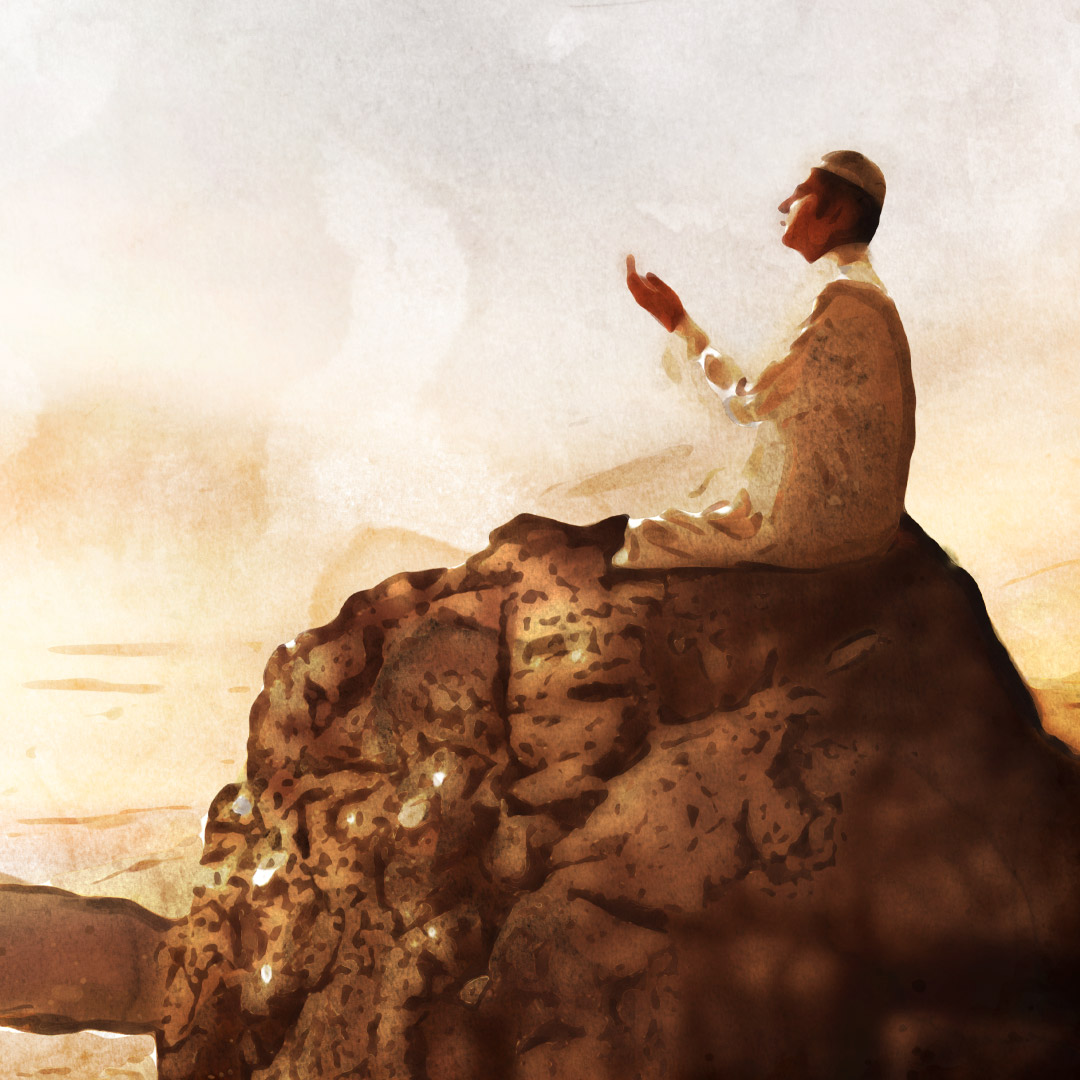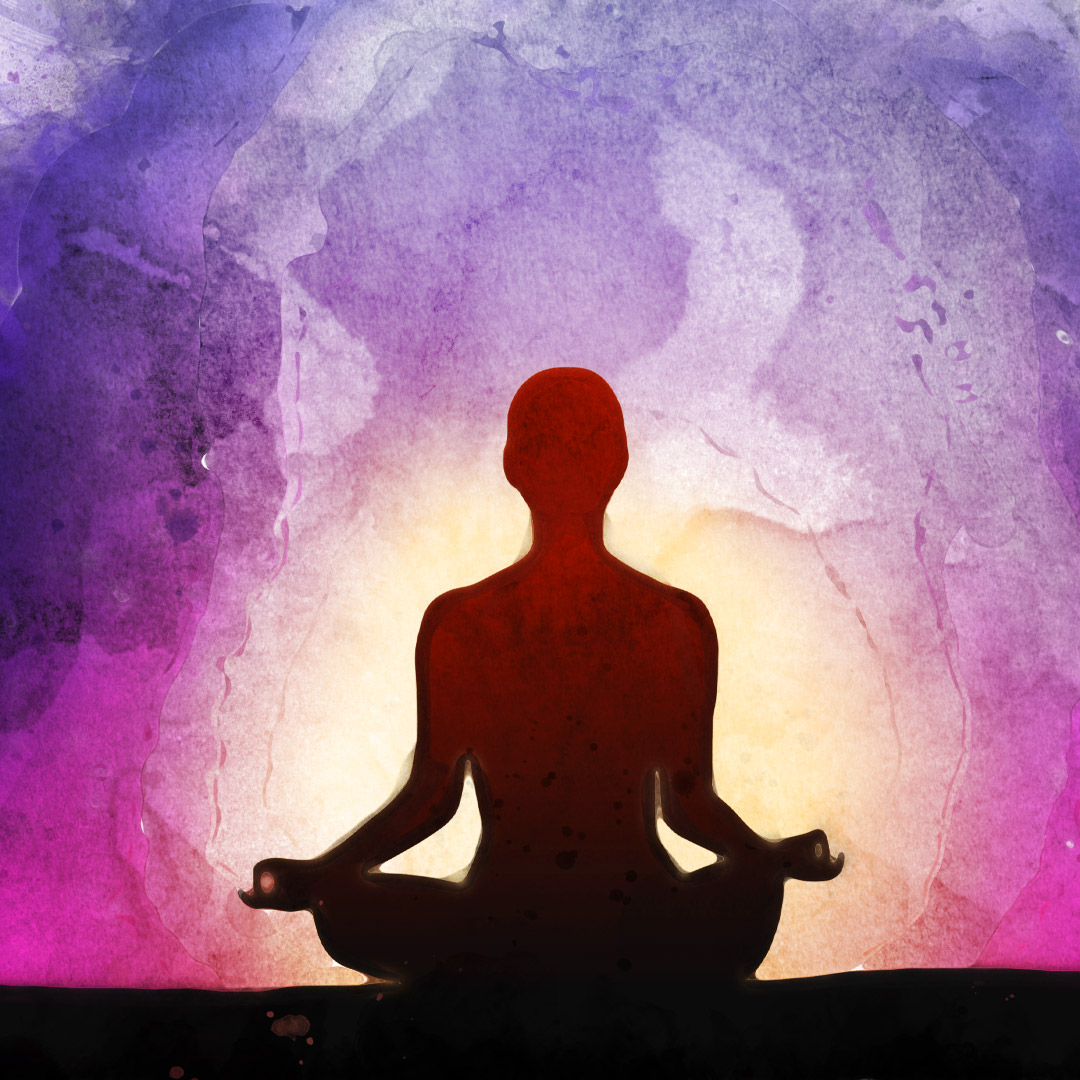What is Meditation? | Significance and History | Benefits of Meditation | Types of Meditation
What is meditation?

Meditation has become a very popular practise as the world has been waking up to its benefits since the turn of the millennium. People are increasingly adopting lifestyles that involve the practice of meditation. Yet, when it comes to defining the word, a lot of confusion surrounds this wide and fluid idea. Meditation in its purest essence is the act of concentration on the universal consciousness.
“By the practice of meditation, you will find that you are carrying within your heart a portable paradise.”
-Paramahansa Yogananda
Meditation for beginners
We understand that starting a meditation practise can seem daunting, which is why we have made all our meditations short and simple so that it is easy for you to discover your own meditation style. Follow our meditation for beginners guide and try out a few quick meditations.

Significance and history
The oldest mention of meditation can be found in the Vedas, written in 1,500 BCE. Until that point, methods of meditation were only taught verbally. Evidence has been found to suggest meditation had first originated in India, around 5,000 years ago.
Christianity defines meditation as a contemplative prayer that helps you become one with God. Developed by Christian mystics, it involves either silently contemplating God or repeating a specific phrase or word. The Jesus Prayer is a common form of Christian meditation, and it was first developed in Greece sometime between the 10th and 14th centuries.
Where there is peace and meditation, there is neither anxiety nor doubt.
– St Francis De Sales
Buddhism, on the other hand, uses meditation as one of the tools to achieve Nirvana and purify the mind. Buddha is known for his meditational practices and teachings during the 6th century BCE.
Meditation practices are common in Islam, too. Initiated by the Sufis at least 1,400 years ago, this form of the practice involves gazing, sacred phrases, recitation, and breathing practices.
Meditation is followed by many other faiths including Jainism, Confucianism, Taoism, Zen Buddhism, and Judaism, among others.
Benefits of meditation

Meditation offers myriad spiritual and scientific benefits. Regular practice of meditation can help reduce stress, as suggested by a research article(2), which also concludes that meditation can play a significant role in the reduction of many negative effects of psychological stress.
Through meditation, the Higher Self is experienced.
– Bhagavad Gita
Medication can offer an accessible process of self-care that has the ability to help the practitioner with mental well-being and self-regulate personal behavior. (3)
Other than the above mentioned scientific benefits, many studies suggest that meditating regularly can also help control anxiety, improve self-awareness, enhance attention span, help reduce memory loss, fight addictions, and do much more to improve your physical and mental health.
Types of meditation
Meditation can be primarily segmented into three simple categories based on their primary technique related to either the physical body, the mind or the soul, and any one type of practice may belong to more than just one.
Having come to realize in the first stage of meditation that we are not our bodies, in the second stage we make an even more astounding discovery; we are not our minds either.
– Eknath Easwaran
Body (Physical) Meditation

Meditation that deal primarily with bodily processes are categorized here:
Progressive muscle relaxation: This form of meditation is practiced by mentally scanning your body to find any kind of sensation and then focusing on it. It helps you reconnect with your body, experience the sensory paradigm, be focused, and find relaxation.
Trataka meditation: To perform this, you need to practice concentrated gazing. It can purify your eyes to leave them clear and bright, strengthen your focus, and cleanse your mind.
Do not dwell in the past, do not dream of the future, concentrate the mind on the present moment.
– Buddha
Shavasana: Shavasana Meditation is a practice that you must perform after finishing other yoga exercises(7). “Shav” means ‘dead body’ and “Asana” means ‘yoga posture’. The name ‘Shavasana’ is derived from the fact that the practitioners must lie down like a “dead body” to perform this meditation.

Yoga Nidra: The meaning of Yoga Nidra is “psychic sleep(8)”. During this meditation, the practitioners can maintain awareness while connecting to subconsciousness and higher consciousness. Many people go to bed still worrying about life and life’s problems. This interferes with the quality of their sleep, resulting in lethargy and sleepiness in the morning. Practicing Yoga Nidra Meditation before sleeping, relaxes the mind and body, which leads to deeper and better sleep.
Alternate Nostril Breathing: When the subtle energy channels in our body are blocked, our vital energy cannot move freely, thus resulting in anxiety, anger, fear and other negative emotions(9). Alternate Nostril Breathing Meditation purifies the channels or Nadis. The practice mainly focuses on two Nadis: the right nostril (Pingala) that is linked to the left-brain functions, and the left nostril (Ida) that is linked to the right-brain functions.
Nose Tip Gazing: The key purpose of Nose Tip Gazing Meditation is to improve the practitioner’s ability to focus. Regularly meditating this way with awareness can also awaken your Mooldhara (Root) Chakra(10). But it can take anywhere from days, to an entire lifetime or beyond to attain the result. It solely depends on the spiritual evolution of the practitioner’s soul.
The affairs of the world will go on forever. Do not delay the practice of meditation.
– Milarepa
All Senses Meditation: All Senses Meditation involves paying attention to all your senses: sight, touch, sound, smell and taste(11). This technique is really helpful when it comes to centering yourself and feeling at home within yourself.

Breath awareness: This is a very simple form of meditation. You sit down with your eyes closed and calm your entire body. Once you feel relaxed, concentrate on the natural flow of your breathing. Being mindful about the breathing rate and depth can help you feel more at peace.
Drishti Dhyana Meditation: Drishti Dhyana or the practice of focused visualization, is considered to be a superior form of meditation that can help eliminate worldly desires(12). This is one technique that can be useful for both beginner and experienced meditators as it does not require anything but a single point for focus. It is found in ancient Indian texts that Lord Ram once instructed Hanuman to practice Drishti Dhyana. He said, “Oh Hanuman, until the mind is controlled, one must meditate on a single element.”
Yathabhimatadhyanadva (Positive aspect meditation): Yathabhimatadhyanadva is one of the rare forms of meditation where the meditators have the complete freedom to choose the object of focus(13). It can be anything such as an idol, a sound, an object of devotion, or something else that makes you feel positive and peaceful. It is the most effective way to steady your mind and control it.
Wherever you are is the entry point.
– Kabir
Vedic (Sthula Dhyana) Meditation: Sthula Dhyana is a meditation method where the practitioners focus on the deities or Gurus of their choice and contemplate on their form. To meditate this way, the meditators picture an image of the deity in their mind and allow themselves to become absorbed in it. This is one technique where the role of the practitioner is greater as he or she can experience the Almighty only by properly performing the Sthula Dhyana(14).
Isha Kriya Meditation: Isha Kriya is a powerful but simple meditation technique that originates from the timeless yogic sciences. The process is taught by Sadhguru to help the meditators find the source of their existence, allowing them to create the life they desire(15).
Sudarshan Kriya: This meditation technique allows the practitioners to harmonize their emotions, mind, and body to their natural breathing rhythm. by practicing this method, one can eliminate negative emotions, fatigue, and stress(16).
Zhuanqi: Zhuanqi is a breathing meditation method that originated from Taoist traditions. The purpose of this practice is to pay attention to your breathing until it becomes completely soft. This is a similar technique to Mindfulness Meditation in Buddhism. By practicing Zhuanqi, one can calm their mind and body. It helps the meditator harmonize with their surroundings by simply observing the inhalation and exhalation process, which quiets down the breathing, ultimately leading to the union of mind and qi (breath). The practice can help improve your health and find inner peace(17).
Qigong meditation: It is a form of ancient Chinese healing exercise that combines meditation with physical movement and controlled breathing. Through this technique, the meditators can achieve good health and spirituality(18).
The Way to do is to be.
― Lao Tzu
Mind (Mental) Meditation
Meditation that deal primarily with mental processes are categorized here:
Mantra meditation: This combines mindful meditation with silent mantra repetition. Choose the mantra carefully to ensure that it connects you to the Divine and offers the possibility for your mind to awaken. According to a research article(7), multiple reviews have reported that mantra meditation can ease emotional conditions such as depression, anxiety, and stress; and also reduce physical pain, thereby improving the quality of mental health.

Om Meditation: The sound Om is made of three letters: A, U, and M. Om is believed to be a primordial sound, and all other sounds emerge from it. The three letters of the sound Om (A, U, and M) represent the gross, subtle, and casual aspects of every Cosmic Being. It is believed that Om is the only word that signifies Ultimate Reality. Thus, Om is considered the most powerful name of God(2). Meditating on Om is a potent technique that involves not only uttering the word but also focusing on the silence, which is known to be the joy of God. Om Meditation has the ability to calm down the practitioners’ mind and help it focus better(31).
Gayatri Meditation: According to Vedanta, the Gayatri Mantra is the most sacred and potent. Gayatri Mantra is believed to be supreme and glorious, which makes it an effective object of meditation, suitable for everyone. The practitioners of Gayatri Meditation trust it to be a spiritual armor that can protect them from negativity and bless them with divine illumination(32).
Simran Meditation: Simran Meditation involves the repetition of the Name of God, which helps the practitioners to realize the Almighty, the Truth, and the Reality. Through this practice, one can achieve freedom from the cycle of life and death. It also assists the meditators to find peace in their life.
Kirtan meditation: Kirtan is the method of praising the Lord through different expressions such as poetry, dance, drama, and different forms of oral recitation. The most popular form of Kirtan is singing a mantra that praises any form of the Almighty.
Soham mantra meditation: Soham mantra meditation is similar to breath awareness meditation, but here you need to repeat the “Soham” mantra. Say “So” as you inhale and “ham” or “hum” when you exhale. The mantra helps you to focus on breathing more naturally.
Vedic Meditation: These forms of meditations like Vedic Meditation (Sthula Dhyana) and Vedic Meditation (Bhakti Yoga Samadhi), have their roots in the ancient vedic texts of India that are also the foundation of yoga and dhyana.

Loving kindness meditation: This form of meditation gives you enhanced mental security. In metta meditation, we send love to the universe, but in loving kindness meditation we not only send love and kindness but we also meditate on receiving them from our loved ones. To practice this, sit in silence and imagine your loved ones sending you kindness and love. After a while, imagine sending them your love and kindness, in return.
Truth is the offspring of silence and meditation
– Isaac Newton
Chakra meditation: Chakras are energy centers that reside within our body. There are seven core chakras that must remain healthy for our physical and mental well-being.
Passage meditation: This form of meditation was developed by Eknath Easwaran. For this, you need to first memorize an inspirational and uplifting passage of text, and then repeat it in your mind while meditating with your eyes closed. You can practice this form of meditation while seated on the floor or on a chair.
Metta meditation: This form of meditation was taught by Buddha 2,600 years ago and it helps you to wish well for everything in existence through meditation. To start, you simply need to sit down, breathe, and wish health, happiness, and safety for someone you love.
Twin hearts meditation: The heart is made up of two sections, emotional and spiritual. With this meditation technique, you can focus on connecting the two with your physical self to improve your overall health and well-being. This meditation practice was created by Grandmaster Choa Kok Sui.
Whenever we attain a higher vision, the lower vision disappears of itself.
– Swami Vivekananda
Vipassana meditation: This is one of the most ancient forms of meditation, discovered in India. Practiced by the famous Gotama Buddha, who started teaching it around 2,500 years ago, Vipassana means observing things as they are in reality, focusing on the deep interconnectedness of the mind and body. It helps your mind to be liberated completely and achieve self-realization.
Mindfulness-Based Stress Reduction (MBSR): When we hear of any stressful event, we always instantly react to it out of habit. However, there is a moment before the reaction when we can choose how we respond to a certain situation. Choosing the right reaction can help you avoid stress. MBSR meditation, developed by Professor Jon Kabat-Zinn at the University of Massachusetts Medical Center, helps us to be mindful about that moment and find more mental stability. According to a research article(5), MBSR can reduce stress, depression, and anxiety. To do this, focus on one thing in the moment; your each step, your each breath, or a single sight or sound.
Transcendental meditation®: This method can be learnt from a certified transcendental meditation teacher. According to a research article(4), transcendental meditation can decrease blood pressure, reduce addictions, lower cholesterol, and lessen psychosocial stress.
Koan: Koans are stories from Zen Buddhism that do not try to explain things. Instead, they open up a spiritual door for you and invite you on a journey. They help you realize that you are a part of the world and everything in it: the rivers, the forests, cities, and the sky. Koans help you realize that your life matters. While meditation takes you beyond things that you already know and life’s illusions, Koan Meditation is little different from that. The practice teaches you to focus on what you already have and value it(19).
What is the sound of one hand clapping?
– A Zen Koan
Dzogchen: Do not consider Dzogchen simply as a meditation technique or a philosophy. It is an elemental state of complete awakening: the essence of Buddhism and every other spiritual path. It is believed in Buddhist philosophy that with Dzogchen Meditation, it is possible to attain complete liberation. But it requires complete dedication and continuous practice from the meditator(20).
Shikantaza: Shikantaza is a practice that requires the meditator to settle their mind but without fixing it on anything specific. This practice helps you achieve awareness independent of any subject or object. During the practice of Shikantaza Meditation, you become aware of your own presence along with the sights, feelings, sounds, thoughts, movements and sensations that surround you(21).
Zuowang: Zuowang is one of the most prominent Daoist meditation practices and it is based on the idea of sitting in forgetfulness. This meditation focuses on doing nothing and turning off your intellectual thoughts so you can enter pure awareness. Zuowang requires you to imagine that your body is completely empty; there is no intellect, mind or thoughts. With none of the reasoning faculties present inside the body, what solely remains is awareness(22).
Be the witness of your thoughts. You are what observes, not what you observe.
– Buddhist proverb
Neiguan: Neiguan is the fourth most important meditation practice in the Taoist tradition. The technique involves visualizing the inside of your body, mind, internal organs, thoughts and the movements of qi or one’s vital force. Through this practice, the meditator can familiarize themselves with nature’s wisdom existing within their body(23).
Kirtan Kriya: Kirtan Kriya is considered to be one of the highest forms of devotional meditations. During the meditation, one has to repeat the chant, “Saa Taa Naa Maa,”–words believed to be the sounds of life. Each sound creates a vibration in the mind and body. Kirtan Meditation has the potential to help you become more devotional, break bad habits, and manage life’s transitions more easily. It is believed that the technique can also heal trauma and negative memories(24).
Mahavakya: Mahavakya Meditation involves using any of the four great sayings from the Vedas as the object of meditation, helping meditators to attain wisdom and insight. The four Vedic Mahavakyas are Prajnanam Brahma ( Consciousness is Brahman), Tat Twam Asi (That you are), Ayam Atma Brahma ( This Atma or Individual Self is Brahman), and Aham Brahmasmi (I am Brahman)(25).
Our life is shaped by our mind, for we become what we think.
– Buddha

Gatha Meditation: A Gatha is a poem or phrase that helps meditators attain mindfulness. Gathas aim to present seemingly ordinary things in ways that reveal their hidden wisdom and beauty. Gatha Meditation can help you find bliss even in the most tedious activities. During this practice, the practitioners coordinate the gatha’s words with the rhythm of their breathing(26).
Shamatha Meditation: Shamatha is a key introductory method that leads to the practice of Vipassana or Insight Meditation. During the early stages, the technique involves using different forms of anchors or supports to focus on. But, once the meditators advance in their practice, they are able to cultivate an open awareness of the presence of emptiness. The most traditional object of meditation used in Shamatha is the breath. Through this technique, the practitioners can experience their own mind just as it is(27).
God doesn’t require us to succeed, he only requires that you try.
– Mother Teresa
Jing Zuo Meditation: Jing zuo Meditation is a formless meditation method that requires the practitioners to simply sit quietly. Jing zuo does not depend on too much technique. It is a simple meditation method that has no other goal but to just silently sit and become mindful about the present moment. Jing zuo is a sitting meditation in Confucianism.
Tonglen Meditation: Tonglen Meditation is a Tibetan practice of “sending and receiving,” much like the techniques of Loving-Kindness and Compassion Meditations. Tonglen helps the meditators to connect with themselves as well as others. It helps them be present with their own suffering along with that of someone else. It aims to ignite the practitioners’ compassion and openness by inhaling the suffering of others and exhaling love, joy, and happiness to send them relief(29).
Zazen: Zazen is a practice of being still, allowing your mind to experience the immediate moment, uninterrupted by narratives or thought. It helps you develop concentration power as the meditation process involves focusing on specific actions, like the counting of your breaths. The primary purpose of Zazen meditation is to help you free yourself from attachment to the deluded idea of “self- identity,” so that you may connect with your true nature(30).
What you seek is seeking you.
– Rumi

Shoshuten: According to Taoist beliefs, when the Light or the Chi or energy is allowed to be circulated within the body, it strengthens all the powers of the universe. The method is known as Shoshuten and it is a technique of purifying the energy. In this meditation, Circulation of Light refers to the flow of all the true, creative, and formative powers residing within ourselves(33).
The wound is the place where the Light enters you.
– Rumi
Serene Reflection Meditation: Serene Reflection Meditation is a practice from the Soto Zen Tradition of Buddhism. It intends to help keep the moral Precepts of Buddhism in the practitioners’ external behavior of serving others, along with the inner practice of cleansing one’s heart. It is believed that the technique can help cast off the meditators’ attachment to body and mind naturally, allowing them to attain wisdom and enlightenment. However, it can take anywhere from days to an entire lifetime or beyond to attain the result. It depends on the spiritual evolution of the practitioner’s soul(34).
Self Healing Visualization: This is a powerful visualization technique that can help the meditators eliminate stress from their mind, leading to a stressless body. It encourages relaxation, ensuring that your body and mind heals effectively(35).
Bon Buddhist meditations: The Three Heart Mantras are Bon Buddhist practices that help meditators develop different virtues of Buddha and experience their inherent nature. The Three Heart Mantras belong to the powerful Bon Buddhist practices that aim to awaken the practitioners’ mind so they can recognize their own potential. The mantras also help meditators to achieve healing and non-dual awareness. When practiced together, the three heart mantras lead to complete liberation. These powerful Three Heart Mantras are Du Tri Su, Ma Tri, and Sa Le Od(36).
Anapanasati Meditation: Anapanasati Meditation is a method where the meditators use mindful breathing to develop both the ability to see the true nature of things (Vipassana), and a concentrated, serene mind (Samadhi). This practice uses breathing as an object of focus. This method was particularly taught by Buddha himself, and it is believed that he used Anapanasati Meditation to achieve complete awakening(37).

Japanese meditations: These Japanese’s meditations are parts of the Shin-shin-toitsu-do, Japanese yoga exercises, which help to develop willpower and self-awareness, while improving physical and mental health.
Maranatha meditation: It is a prayer based meditation technique which involves inhaling and exhaling with the rhythm of Ma-Ra-Na-Tha (which means “Come Lord”). The practice helps meditators to open their hearts and invite the Lord(38).
The quieter you become, the more you are able to hear.
– Rumi
Soul (Spiritual) Meditation
Meditation that deal primarily with spiritual processes are categorized here:
Prayer meditation: This requires you to meditate on a prayer in the name of the Almighty. A good example of this is the Christian prayer “Kyrie Eleison, Christe Eleison”.
Chanting meditation: One of the most effective ways to perform divine meditation is to chant sacred sounds to produce an altered state of consciousness. These sounds have calming and healing powers that can influence overall well-being. As per a research article(6), chanting meditation can improve cerebral blood flow and brain function.

Third Eye meditation: Bhrumadhya is the front part of the Ajna Chakra, also known as the Third Eye Chakra. Third Eye Meditation is a very important ancient practice. Through this meditation, you can awaken and free your Divine Energy. Regular practice of Third Eye Meditation can ensure this, but it can take anywhere from days to an entire lifetime, or beyond to attain the result. It solely depends on the spiritual evolution of the practitioner’s soul. The meditation also calms your mind, helping reduce anger and stress(39).
Half an hour’s meditation each day is essential, except when you are busy. Then a full hour is needed.
– St. Francis de Sales
Gregorian Chant Meditation: Gregorian Chant is the traditional music used in Roman Churches, and it comes with a rich history of 2000 years. It is one form of the many Christian chats that is still used today in many Roman Churches across the globe.
Sound Nada meditation: Nada means ‘sound’. Nada Meditation is a practice that uses sound as a medium of focus to penetrate the mind’s deeper layers(2). According to science, the universe is a continuous interplay between different forms of sound and energy vibrations. Yoga believes that the layers of our mind are also made of countless sound vibrations. Nada Meditation takes the practitioners through these subtle sounds to help them disassociate their mind from their surroundings and other senses. This practice can assist you to reach a greater state of meditation(40).
Who am I?: To be happy is an innate desire among all living beings and it can truly be experienced when you know your real self. The “Who Am I?” Meditation is one of the primary means to help discover one’s true self as it encourages the practitioner to enquire about who they really are(2). But to know one’s true self is possible only when you have a clear understanding of who you are not(41).
Tafakkur: Tafakkur is an Islamic worship technique that requires combining one’s spirit, emotions, and the rational mind. The aim of Tafakkur is spiritual contemplation. The technique involves worshiping Allah and appreciating the creations of Allah that exist in the universe(42).

Dhikr: Dhikr, also known as ‘Zikr’, is an Islamic form of worshiping the Almighty. There are multiple translations of the word Dhikr, including “to remember,” “to praise,” “to recollect,” “to mention,” and “to commemorate.” Dhikr is the most dominant form of Islamic meditation. Dhikr Meditation is a devotional act of remembering God by repeating short prayers. These are recited silently in the mind or aloud(43).
What we speak becomes the house we live in.
– Hafiz
Muraqabah: Muraqabah is a Sufi meditation method which helps practitioners to break free from the illusion of the physical world, so they can find what is authentically real. It is believed that our default condition is to exist in an illusion that what we sense in the material world is all there is. With the continuous practice of Muraqabah, meditators can attain spiritual development, which opens the door to the True Reality, the only one that must matter(44).
Lectio Divina: Lectio Divina means “sacred or holy reading.” It is a form of ancient Christian prayers, involving the slow reading of holy scriptures and praying. The purpose of the practice is not to collect information from holy texts but to allow the words’ value to spiritually influence us. It is believed that through Lectio Divina, the meditators can find and familiarize with the Almighty. Lectio Divina also helps the practitioners to develop a sacred connection with the Holy Words. When one does so, it can shape the way they live their life(45).
Gregorian chant:
Kriya Yoga: Kriya Yoga contains the distilled essence of Raja Yoga, the royal path, and consists of advanced techniques of meditation whose devoted practice leads to realization of God and liberation of the soul from all forms of bondage. This sacred science was brought to the world by Paramahansa Yogananda at the behest of his God-attuned line of gurus — Mahavatar Babaji, Lahiri Mahasaya, and Swami Sri Yukteswar. (46)
Let it all go, The body and the mind. Let yourself dissolve.
– The Ashtavakra Gita
Preksha Dhyana: Preksha Dhyana is a meditation of Vision or seeing. The technique is based on ancient wisdom and it encourages changes in the meditators’ behavioral patterns. Preksha Dhyana can successfully revitalize bodily cells and improve blood circulation. By committing to this technique, you can also make your respiration more efficient and train your mind to concentrate better. Practicing Preksha Dhyana meditation does not require you to belong to any particular creed. Anyone can benefit from this meditation through regular practice(47).
Centering Prayer (Christian): Centering Prayer is a method of silently resting in the presence of God. Even though the technique derives from Christian contemplative meditation traditions, its scope is not limited to one religion. Any meditator, seeking to deepen their relationship with the Almighty, can benefit from this practice. But it can take anywhere from days to an entire lifetime or beyond to attain the result. It depends on the spiritual evolution of the practitioner’s soul(48).
Hitbodedut: It is a self-isolating Jewish technique, first made popular by Rebbe Nachman of Breslov. The practice involves open, direct, and spontaneous communication with the Almighty. The meditation encourages embracing one’s vulnerabilities and opening their hearts completely(49).
Besides these there are many more meditations concerned with the upliftment of body, mind and soul like
The Ruhgu app has a large library of simple meditations for you to begin your meditative practise. Try out a few short meditations and discover your meditation style. Also experience sacred music, chants, meditation music and more to help you in your meditative practise.
References
1. Proceedings of the National Academy of Sciences of the United States of America | Neural correlates of attentional expertise in long-term meditation practitioners
2. JAMA Internal Medicine | Meditation Programs for Psychological Stress and Well-being
3. BioMed Central | Prevalence and patterns of use of mantra, mindfulness and spiritual meditation among adults in the United States
4. Cardiology in Review | Review of Controlled Research on the Transcendental Meditation Program and Cardiovascular Disease
5. National Centre for Biotechnology Information | Effects of Mindfulness-Based Stress Reduction (MBSR) on Emotion Regulation in Social Anxiety Disorder
6. Nuclear Medicine Communications | Cerebral blood flow changes during chanting meditation
7. The Divine Life Society | Hatha Yoga by Swami Sivananda | Shavasana
8. Prakash Pubns & Export | Meditations from the Tantras by Swami Satyananda Saraswati
9. Pendragon Pub | Guiding Yoga’s Light: Yoga Lessons for Yoga Teachers by Nancy Gerstein
10. Prakash Pubns & Export | Meditations from the Tantras by Swami Satyananda Saraswati
11. Mindful.org | A Meditation for Exploring Your Senses by Cara Bradley
12. Santmat Society of North America | Harmony of All Religions by Maharishi Santsevi Ji Maharaj
13. Yoga Publications Trust | Four Chapters on Freedom: Commentary on the Yoga Sutras of Patanjali by Swami Satyananda Saraswati
14. Council for Research in Values and Philosophy | Paths to the Divine: Ancient and Indian by Vensus A. George
15. Sadhguru | Isha Kriya
16. Art of Living | What is Sudarshan Kriya?
17. John Hunt Publishing | Pagan Portals – Meditation by Rachel Patterson
18. Livescience | What is Qigong? by Elizabeth Palermo
19. Lion’s Roar | The Essential Guide to How to Meditate | Zen Koans by John Tarrant
20. Ebury Publishing | The Tibetan Book Of Living And Dying: A Spiritual Classic from One of the Foremost Interpreters of Tibetan Buddhism to the West by Sogyal Rinpoche
21. Penguin Books Limited | Meditation Now or Never by Steve Hagen
22. Fingerprint! Publishing | 112 Meditations for Self Realization: Vigyan Bhairava Tantra, Translation and Commentary by Ranjit Chaudhri
23. Psycho Information Technologies | Psychology of Meditation: A Practical Guide to Self-Discovery by Dr. Akbar Husain and Dr. Asif Hasan
24. Avery | A Woman’s Book of Meditation: Discovering the Power of a Peaceful Mind by Hari Kaur Khalsa
25. SkyLight Paths Pub | Meditation & Its Practices: A Definitive Guide to Techniques and Traditions of Meditation in Yoga and Vedanta by Swami Adiswarananda
26. New World Library | Beginning Mindfulness: Learning the Way of Awareness by Andrew Weiss
27. Lion’s Roar | The Essential Guide to How to Meditate | Shamatha Meditation by Lama Rod Owens
28. Springer International Publishing | Spirituality and Sustainability: New Horizons and Exemplary Approaches, Edited by Joan Marques and Satinder Dhiman
29. Fair Winds Press | Meditation Made Simple: Weekly Practices for Relieving Stress, Finding Balance, and Cultivating Joy by Paula Watson
30. Lion’s Roar | The Essential Guide to How to Meditate | Zazen by Jules Shuzen Harris
31. Balboa Press | The Power of Om by Meena Bhojwani
32. Motilal Banarsidass Publishers | Gāyatrī, the Highest Meditation by Keshavadas (Satguru Sant)
33. Mariner Books | Secret of the Golden Flower: A Chinese Book of Life (Paperback) by Tung-Pin Lu (Translated by Richard Wilhelm)
34. Shasta Abbey | Serene Reflection Meditation (Paperback) by Rev. Master P.T.N.H. Jiyu-Kennett
35. Mindworks | Meditation for Healing
36. olmoling.org | Essence of the Three Heart Mantras of Bon by Tempa Dukte Lama
37. Yoga Journal | 2002 | Guided Meditation by Larry Rosenberg | Breathing Lessons
38. Swamij.com | Maranatha
39. Prakash Pubns & Export | Meditations from the Tantras by Swami Satyananda Saraswati
40. Prakash Pubns & Export | Meditations from the Tantras | by Swami Satyananda Saraswati
41. Createspace Independent Pub | Happiness and the Art of Being: An Introduction to the Philosophy and Practice of the Spiritual Teachings of Bhagavan Sri Ramana (Second Edition) by Michael James
42. Mahya Yayıncılık | Contemplation: An Islamic Psychospiritual Study by Malik Badri
43. iUniverse | Remember Me, and I Will Remember You: Dhikr: The Soul of Islam by Tallal Alie Turfe
44. Islamic Supreme Council of America | The Healing Power of Sufi Meditation by Sayyid Nurjan Mirahmadi and Hedieh Mirahmadi
45. Paulist Press | Lectio Divina: Contemplative Awakening and Awareness by Christine Valters Paintner and Lucy Wynkoop
46. yssofindia.org|The Kriya Yoga Path of Meditation
47. Preksha Dhyana by Yuvacharya Mahaprajna | Translated by Muni Mahendra Kumar and Jethalal S. Zaveri
48. Cascade Books | Centering Prayer for Everyone: With Readings, Programs, and Instructions for Home and Group Practice by Lindsay Boyer
49. Reformjudaism.org | 3 Steps to Hitbodedut: Talking to God on Your Own Terms by Chris Harrison



















